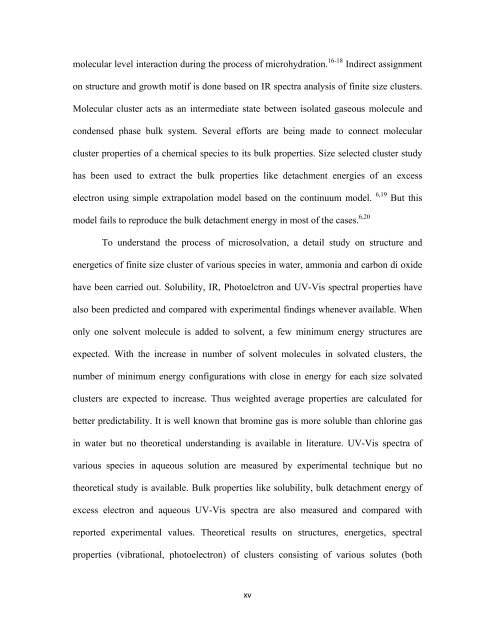CHEM01200604005 A. K. Pathak - Homi Bhabha National Institute
CHEM01200604005 A. K. Pathak - Homi Bhabha National Institute
CHEM01200604005 A. K. Pathak - Homi Bhabha National Institute
Create successful ePaper yourself
Turn your PDF publications into a flip-book with our unique Google optimized e-Paper software.
molecular level interaction during the process of microhydration. 16-18 Indirect assignment<br />
on structure and growth motif is done based on IR spectra analysis of finite size clusters.<br />
Molecular cluster acts as an intermediate state between isolated gaseous molecule and<br />
condensed phase bulk system. Several efforts are being made to connect molecular<br />
cluster properties of a chemical species to its bulk properties. Size selected cluster study<br />
has been used to extract the bulk properties like detachment energies of an excess<br />
electron using simple extrapolation model based on the continuum model. 6,19 But this<br />
model fails to reproduce the bulk detachment energy in most of the cases. 6,20<br />
To understand the process of microsolvation, a detail study on structure and<br />
energetics of finite size cluster of various species in water, ammonia and carbon di oxide<br />
have been carried out. Solubility, IR, Photoelctron and UV-Vis spectral properties have<br />
also been predicted and compared with experimental findings whenever available. When<br />
only one solvent molecule is added to solvent, a few minimum energy structures are<br />
expected. With the increase in number of solvent molecules in solvated clusters, the<br />
number of minimum energy configurations with close in energy for each size solvated<br />
clusters are expected to increase. Thus weighted average properties are calculated for<br />
better predictability. It is well known that bromine gas is more soluble than chlorine gas<br />
in water but no theoretical understanding is available in literature. UV-Vis spectra of<br />
various species in aqueous solution are measured by experimental technique but no<br />
theoretical study is available. Bulk properties like solubility, bulk detachment energy of<br />
excess electron and aqueous UV-Vis spectra are also measured and compared with<br />
reported experimental values. Theoretical results on structures, energetics, spectral<br />
properties (vibrational, photoelectron) of clusters consisting of various solutes (both<br />
xv
















